By Jack Rooney
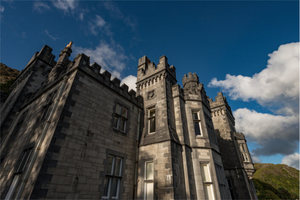 Kylemore Castle
Kylemore Castle
The community of Benedictine nuns at Kylemore Abbey arrived at its current home on the west coast of Ireland nearly 100 years ago, and since then the sisters have become an Irish institution.
They turned one of the most spectacular private residences in the country into a world-renowned boarding school, educating girls from around the globe from 1923 until 2010. Today, they help to oversee one of Ireland’s most visited historic sites. In 2016, Kylemore welcomed nearly 460,000 visitors to explore the monastery, Victorian Walled Garden, and Gothic Chapel, and to join the nuns in their centuries-old tradition of Benedictine prayer.
The University of Notre Dame began a partnership with the Kylemore Benedictine community in 2015 and has since completed extensive renovations on the east wing of the abbey. Notre Dame’s Kylemore Abbey Global Center is primed to act as an academic and spiritual hub hosting courses, conferences, and retreats for Notre Dame students and faculty. In March 2018, the Cushwa Center will gather scholars for a symposium at Kylemore, centered on Catholic sisters and their pedagogies of migration.
The Benedictine nuns at Kylemore Abbey, though, have a remarkable history extending long before their arrival at this iconic site. Officially founded in 1665, with roots dating back to 1598, the community had its start in Ypres, a town in western Belgium that once rivaled Bruges and Ghent in both size and commercial importance. Over the next 250 years, the nuns in Ypres—who became affectionately known as the Irish Dames of Ypres—bore extraordinary witness to faith in the face of persecution, and also experienced firsthand some of the most turbulent events in European history.
Birth in exile
Beginning in the mid-16th century, Catholics in England and Ireland faced tremendous cultural and legal oppression. Parliament passed a series of statutes eventually known as the penal laws, which effectively outlawed Catholicism. Under these laws, the Church of England (or the Church of Ireland) was recognized as the official religion of the realm, with the English monarch as supreme head of the Church.
As a result, many faithful English Catholics—mostly wealthy nobles—fled to the continent, where they could continue to practice their religion. Lady Mary Percy, daughter of Blessed Thomas Percy, went to Brussels, where in 1598 she founded a Benedictine community for English women. Four more English Benedictine communities in Belgium and France originated from the Brussels house, beginning with the Ghent community in 1624. The Ghent house, in turn, gave rise to communities at Pontoise, Dunkirk, and finally Ypres in 1665.
 Facade of the old convent on rue Saint-Jacques, Ypres
Facade of the old convent on rue Saint-Jacques, Ypres
The Ypres community was established at the request of the Bishop of Ypres, M. Martin de Praet, who invited several nuns from Ghent and gave them a house and the promise of financial support. A total of six nuns formed the first Ypres community with Dame Marina Beaumont as abbess. The details of the early history of the Ypres Abbey are somewhat unclear, though the most comprehensive account of those years—the diary of Abbess Neville of the Pontoise community—indicates that the Ypres community had lofty expectations for their growth and prosperity.
These hopes quickly ceded to a much more grim reality. The bishop who invited the community died within a year of the abbey’s foundation, leaving the nuns without essential support. The community struggled to recruit novices throughout Beaumont’s time as abbess, and shortly before her death, she considered consolidating the Ypres house into another existing community.
However, before absorption into any other community could take place, Abbess Beaumont died on August 27, 1682. Dame Flavia Cary, one of only three sisters remaining at Ypres, became abbess, and the community would soon be reborn as an Irish house.
Becoming Irish
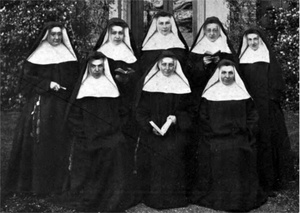 The Irish Dames of Ypres
The Irish Dames of Ypres
Though not Irish herself, Cary is recognized as the first abbess of the Irish community at Ypres. The abbess of the motherhouse at Ghent requested that the other English Benedictine communities in Belgium send their Irish members to Ypres. The abbey in Ypres was rededicated as a house for Irish Benedictine nuns in 1682, officially devoted to the Immaculate Conception under the title of Gratia Dei.
The Ypres community thus became the first specifically Irish religious house in Belgium and for the next 150 years Irish women would serve as abbesses of the community.The Ypres community soon housed nine sisters, not all Irish, before shrinking again to just two nuns at the time of Abbess Cary’s sudden death in February 1686. Her time as abbess of Ypres, while brief, had proven significant. Under her direction, the abbey became Irish rather than English, and several sisters undertook successful fundraising and recruiting trips to Ireland. When Cary died, however, she left the Ypres community much the same way she found it—diminished in numbers and spirit—though this time with surer hope for a future as a burgeoning Irish house.
On August 29, 1686, the community elected Dame Mary Joseph Butler as abbess, and she would lead the community for 37 eventful years. The new abbess belonged to the ancient noble Butler family of County Kilkenny, and her cousin, James, was Duke of Ormond. At age eight, with her father near death, Butler’s mother sent her to study at the Benedictine Abbey at Ghent. She decided to enter the order at age 12 and made her profession in 1657 at age 16.
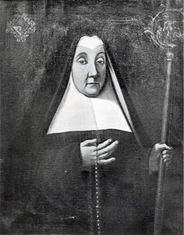 Abbess Butler
Abbess Butler
Less than a year into her tenure as abbess, Butler accepted an invitation that would lead to the most momentous development of the community’s early years. Through the Duke of Tyrconnel, King James II invited Butler to Dublin to establish a Royal Benedictine Abbey in the Irish capital, with the promise of a house and royal patronage.
So, in 1688, Butler and several other Irish Dames left Ypres for Dublin, with plans for the rest of the community to follow later. Along the way, they stopped in London, where Butler met Queen Mary of Modena, a generous benefactor of the community. When the nuns arrived in Dublin on October 31, 1688, they entered a tenuous political situation. The Protestant nobility feared a Catholic monarchy and disliked James II’s close relationship with France, where his cousin, King Louis XIV, reigned.
These fears were realized when the queen gave birth to a son, James, in June 1688, initiating a Catholic line of succession. As a result, several Protestant nobles urged Prince William of Orange, who was married to James II’s Protestant daughter Mary, to invade England and take the crown. William and his army landed in England less than a week after the Irish Dames of Ypres arrived in Dublin, and by the end of the year, King James II had effectively abdicated the throne and fled to France, the end result of what would come to be known as the Glorious Revolution.
Establishing a Dublin abbey
With this political turmoil swirling overhead, the Benedictine community in Dublin sought peace and piety as they entered their new enclosure. The annals of the Ypres community show a life of devotion, daily prayer, and Mass as the sisters settled into their new home on Big Sheep Street (now known as Ship Street Great, directly behind Dublin Castle). The nuns quickly became known for their holiness, which compelled the Catholic gentry in Ireland to send their children to the new abbey for education.
The school run by the Benedictines soon welcomed some 30 girls, 18 of whom desired to enter their community. Abbess Butler sensed the likelihood of war between William and James II, though, and did not immediately admit new entrants to the order. A second, apparently rival, Benedictine community began in Dublin around the same time under the leadership of Dame Mary Joseph O’Ryan, originally a member of the Ypres community. The Archbishop of Dublin supported O’Ryan’s community, while King James specifically chartered Abbess Butler’s community. Nevertheless, O’Ryan established a convent and school for the children of Irish Catholic nobility on Channel Row on the north side of the city.
Despite this rival convent, the community succeeded in attracting scholars and postulants alike. Had the Glorious Revolution not disrupted political and religious life in Ireland, the community likely would have continued to flourish, and perhaps would have given rise to additional Irish Benedictine houses, but the Royal Benedictine Abbey in Dublin would not last. James II returned to Ireland in March of 1689, and promptly convened an Irish parliament that declared him king and passed a law granting religious freedom to all Catholics and Protestants in Ireland. James reigned in Ireland for a little more than a year before William invaded in the summer of 1690.
The two met in the Battle of the Boyne, north of Dublin, on July 1, 1690. The Williamite forces defeated the Jacobites decisively, forcing James to once again flee to France and firmly establishing William as King of England, Ireland, and Scotland. So once again, the Irish Dames of Ypres lost their primary source of support, and would soon return to their exile in Belgium.
Returning to Ypres
Aware of the potential for political upheaval of this sort, the Duke of Tyrconnel, Richard Talbot, had laid the groundwork for the nuns to return to Ypres before they initially left for Dublin. He wrote to the grand vicars of Ypres, who oversaw the Benedictine property there, to ensure that they would preserve it for the Irish Dames should they need to return.
Sure enough, less than three years after the Benedictine sisters arrived in Dublin, they departed as Williamite troops plundered their Ship Street abbey. King William, through Abbess Butler’s cousin the Duke of Ormond, offered the nuns protection if they wished to remain. The nuns declined, and instead accepted the king’s assurance of safe passage back to Belgium.
Upon their return, Abbess Butler had only four lay sisters and no choir Dames remaining in the community. She spent the next five years in extreme poverty and resisted attempts by the Bishop of Ypres and even her own family to convince her to sell the abbey and join another community, where she could live out her life in comfort.
Butler remained devoted to Ypres, and eventually found new entrants and new channels of support. In 1695, four postulants came to Ypres, though only two remained to make their profession. This modest growth together with financial support from Pope Innocent XII, Queen Mary of Modena, and the King of France assured the abbey’s survival through one of its darkest periods.
Several more nuns would join the community before Abbess Butler’s death in 1723, but low numbers of vocations remained the biggest threat to the community. Adding to this concern, the annual contribution from the King of France ceased when the Peace of Utrecht ended the War of Spanish Succession and ceded control of the area including Ypres to Austria.
 Abbey of the Irish Dames from the ramparts
Abbey of the Irish Dames from the ramparts
The war itself did not directly touch Ypres, though the nuns almost certainly monitored its progression across Belgium. To this day the community shares a rather peculiar connection to the war. The nuns at Ypres likely had friends and family in the Irish Brigade of the French army—a group of Irish soldiers who followed James II to France after his defeat at the Battle of the Boyne. The Irish Brigade fought in most battles during the War of Spanish Succession, including the Battle of Ramillies in Central Belgium on May 23, 1706. Legend has it that even as the French army retreated, the Irish Brigade continued to fight the victorious English soldiers, who had captured the Brigade’s regimental flag. The Irish regained possession of the flag and subsequently gave the dark blue banner, featuring a golden harp, to the nuns in Ypres. The Irish Dames hung the flag in their choir for the next two centuries, and it continues to hang in Kylemore Abbey today.
Rebuilding community
Abbess Butler’s niece, Dame M. Magdalen Mandeville, became abbess in 1743. Within a year of her election, war once again visited the Ypres community.
The War of Austrian Succession began in 1741 and involved almost all of the European powers at the time. French troops invaded the Austrian Netherlands in the summer of 1744. On June 10, they arrived at the front door of the abbey at Ypres to offer the nuns safe passage out of the town, which the French planned to siege. The Irish Dames chose to remain in their cloister. The next day, they received a letter from an Irish officer in the French army telling them that he would spare the town, and the abbey, as best he could.
The nuns survived this latest military encounter without harm and continued to live in peace. The rest of Abbess Mandeville’s tenure passed mostly uneventfully. The impoverished community continued to struggle with few new vocations. Two more nuns joined the community under Abbess Mandeville, and one beloved older sister died. Mandeville herself died on November 27, 1760.
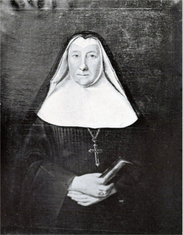 Abbess Dalton
Abbess Dalton
Dame Mary Bernard Dalton succeeded Mandeville as abbess and led the community for 23 relatively peaceful years. In 1766, she enrolled the community in the Confraternity of the Sacred Heart in Bruges, which formalized the community’s longstanding devotion to the Sacred Heart. In fact, the Irish Dames at Ypres claimed to have introduced Belgium as a whole to this particular devotion, which honors Jesus’s physical heart—often depicted as flaming, pierced by a lance, and encircled in a crown of thorns—as a representation of the gift of God’s merciful love for humanity in the Incarnation. In practice, the devotion is expressed in particular prayers and hymns including the Salutation to the Sacred Heart and the Litany of the Sacred Heart. The community’s devotion continues today and is most visible in the statue of the Sacred Heart of Jesus that stands roughly halfway up the mountain behind Kylemore Abbey.
Abbess Dalton, like many of her predecessors, struggled to recruit new sisters. In the last several years of her tenure, though, eight women joined the community, even as dark days loomed on the horizon.
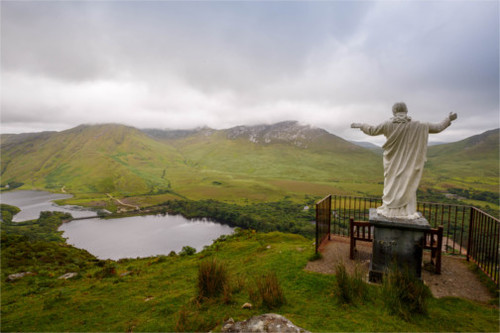
Facing the French Revolution
Following Dalton’s death in 1783, the community unanimously elected the young Dame Scholastica Lynch as abbess. Six years into her tenure, the French Revolution erupted, though violence would not reach Belgium until 1792.
 Abbess Lynch
Abbess Lynch
On January 13, 1793, invading French troops reached the front door of the Benedictine Abbey at Ypres. Some 40 to 50 soldiers demanded entrance into the enclosure. Abbess Lynch refused. The troops, threatening to fire their cannons on the abbey, broke down the doors and searched the house for anything of value. They drank heavily at the abbey that night and slept in the outer parlor. The next morning, the nuns learned that an Irish general commanded these troops, so Abbess Lynch contacted him to seek relief. The general, Irish Republican James O’Moran, apologized for his unruly soldiers and paid for the damages they had caused.
The Irish Dames averted disaster, but the French Revolution would visit their peaceful enclosure again the following year. The French surrounded Ypres in June 1794, and laid siege to the town for 15 days. Several bombs fell into the convent garden, which was situated dangerously close to the ramparts. One of the explosions set fire to surrounding houses, killing several residents.
The French Republic officially took control of Ypres on June 19, 1794. By October, they had taken over all of Belgium. The Irish Dames continued their peaceful existence, despite persistent harassment from occupying French troops. Abbess Lynch even received five new choir nuns and one new lay sister before her death on June 22, 1799, at just 46 years old. During her tenure, the Ypres Abbey was spared the worst of the revolution’s violence, but the other English-speaking Benedictine communities were not so fortunate. By the end of the French Revolution, Ypres was the only surviving monastery in the Low Countries.
The official annals of the Ypres community end in 1810, so historians know little about the final 20 years of the leadership of Abbess Brigid Bernard Lynch (Scholastica’s sister and successor). By 1810, though, the community had grown to include 10 choir Dames and four lay sisters.
Independence in Belgium and war in Europe
During Brigid Bernard Lynch’s time as abbess, the Dutch once again took control of Belgium, leading her to pray that Belgium would overcome Protestant rule and restore its Catholic heritage. She wrote to Dame Teresa Shuttleworth, abbess of the Benedictine community in Staffordshire, England (formerly at Ghent), “Do pray hard and get as many holy persons as you can to implore God’s mercy thro’ the powerful intercession of Our Blessed Lady in behalf of this afflicted country.”
God answered those prayers on August 25, 1830—four days after Lynch’s death—when riots broke out in Brussels. Belgians drew inspiration from the success of the July Revolution in France as well as a Brussels performance of the opera La muette de Portici, and independence movements spread throughout the country.
With revolution in the air, the Ypres community elected Dame Mary Benedict Byrne as its next abbess. By April of the following year, the revolution had reached Ypres, where anti-Dutch riots erupted. In June 1831, Belgium elected Prince Leopold as king of the new, independent constitutional monarchy
.After leading the community through the Belgian Revolution, Abbess Byrne died on January 12, 1840. She was the seventh Irish abbess of the Ypres community, and the last Irish-born leader of the community until 1941. Dame Elizabeth Jarrett, a native of London, succeeded her as abbess, and would lead the community for the next 48 years.
For a time during Abbess Jarrett’s regime, the Ypres community did not include a single Irish nun. In 1854, though, Irish-born Dame Mary Josephine Fletcher arrived at Ypres, and would be with the community for the remainder of its time in Belgium. Due to old age, Jarrett effectively resigned as abbess in 1885, and died three years later after nearly a half-century leading the community.
Upon her death, Dame Mary Scholastica Bergé, a Belgian-born sister who had entered the house in 1850 at age 20, became abbess. Under Bergé, the community began to grow again, including increasing numbers of Irish nuns. This promising growth, though, gave way to grave concern when war once again disrupted the peaceful lives of the Irish Dames of Ypres, this time with permanent consequence.
Fleeing Ypres
For all the wars and political turmoil that had affected the nuns in their nearly 250 years at Ypres, they had never witnessed anything like the violence that began with a single gunshot on June 28, 1914. Over the next four and a half years, the Great War would engulf all of Europe, and the unprecedented destruction of those years would compel unprecedented action by the Irish Dames of Ypres.
The Irish Nuns at Ypres: An Episode of the War, a book based on personal diaries of community members and edited by Dame M. Columban Plomer, details the community’s dramatic escape from Belgium in November 1914. Perhaps the first published account of World War I written by women, the book includes an introduction by John E. Redmond, M.P., then leader of the Irish Parliamentary Party and uncle to Dame Teresa Howard. The account begins in September 1914, with Ypres under light and noise restriction and rumors swirling that the Germans would soon reach the town.
The community at that time included Irish, English, Luxembourgish, and Germans among its 18 nuns and one novice. Belgium passed a wartime law requiring all German nationals to leave the country, and on September 7, an officer came to the monastery to inform the four German sisters that they would have to leave, marking the war’s first direct impact on the nuns.
Exactly one month later, German forces invaded Ypres, and gunfire literally shook the abbey while the nuns continued with their daily prayer routine. Throughout their entire experience of the war, the nuns prayed fervently for peace, especially through the intercession of the Sacred Heart. The aged Dame Josephine Fletcher prayed to Ireland’s patron, “Dear St. Patrick, as you once chased the serpents and venomous reptiles out of Ireland, please now chase the Germans out of Belgium!”
Ypres found temporary relief after the initial German invasion. Allied troops arrived a week later and defended the town for more than a month against increasingly intense German bombardment. In his introduction to The Irish Nuns at Ypres, Redmond wrote that between October 11 and November 20, “Ypres was probably the centre of the most terrible fighting of the war.”
During the Battle of Ypres, the Irish Dames scrounged what food they could to feed themselves and the growing number of troops and refugees in the town. They provided shelter to wounded French soldiers and townspeople fleeing the violence, housing up to 57 people per night. They gathered the abbey’s valuables and prepared room in the cellar to take shelter when fighting intensified. And, since they could not leave their enclosure, the nuns relied on friends to feed them information about German advances.
By the end of October, the community decided to send its aging and ailing Abbess Bergé to safety. For the first time since her profession some 60 years prior, the abbess left the Ypres enclosure in a cab that would take her and two other elderly sisters to Poperinge, about nine miles west of Ypres. As the fighting escalated in the coming days and weeks, the community, led by Prioress Mary Maura Ostyn, finally determined that they, too, must escape Ypres.
After attending one final Mass at St. James’s Church in Ypres, the remaining nuns left their abbey in the midafternoon of Friday, November 6, 1914. Moments before they exited the outermost door, the first German shell to strike the abbey sent tremors through the entire building, but all escaped unharmed. The community continued to Poperinge where they reconnected with their abbess and the two others who had accompanied her.
Before fleeing Belgium for good, the community sent three Dames back to Ypres to check on their beloved abbey. The continued German bombardment scarcely affected the exterior of the building, but laid waste to the interior. Holes riddled the roof and debris was scattered throughout the entire building. The nuns collected a few final belongings and said goodbye to their home for the last time.
The Irish Nuns at Ypres records an encounter with a British cavalry regiment as the nuns made their way back to Poperinge, emblematic of the community’s Irish identity which would soon carry them back to their motherland: “They looked at us and shouted: ‘Who are you, Sisters, and where do you come from?’ Dame Columban answered: ‘We are English nuns from the Benedictine Convent of the Rue St. Jacques.’ This was too much for Dame Patrick, who called out: ‘We are no such thing. We are Irish Benedictines!’ ‘Irish!’ shouted half a dozen of them, ‘and so are we,’ and they all began singing, ‘It’s a long way to Tipperary,’ and, thus escorted, we took a long, last look at the dear old town. Needless to say, it was an Irish regiment—every man wore the harp and shamrock on his collar and cap.”
Return to Ireland
Since the outbreak of the war, the abbess of the Benedictine community at Oulton, Staffordshire, England, had offered refuge to the entire Ypres community. After finding transportation to the coast of the English Channel, the Irish Dames of Ypres sailed from Boulogne to Folksestone, in southeast England. From there, they continued to London, where they traveled by train to Staffordshire, arriving on November 24.
Their writings at the time show that the community sincerely hoped and fully intended to return to Ypres after the war ended. Dame Columban wrote in the book detailing their flight from Ypres: “And now, what has God in store for us? We know not! When shall we return to brave little Belgium, and how shall we rebuild our monastery which, as has been said, should this very year celebrate its 250th anniversary?”
While the community pondered such questions, Oulton Abbey provided a welcome return to relative normalcy, and the closing of a historical circle. The Oulton community was originally the Ghent community, from which the Ypres community began. While there, the Irish Dames could pray, read, meditate, and attend Mass in peace.
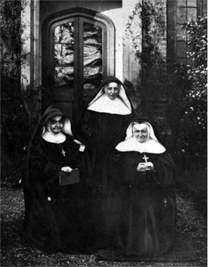 Sisters of the Ypres and Oulton Communities
Sisters of the Ypres and Oulton Communities
Their stay was brief, though. The sisters left Oulton six months after they arrived, and next stayed in London for nine months, as news spread around England and Ireland that the community would be looking for a new home.
During this time in England, and with the help of John Redmond, the Irish Dames of Ypres found a new home in Ireland. They settled at Merton House, Macmine, County Wexford, in February 1916, some two months before the Easter Rising. Over the next four and a half years, the community would add ten new nuns at Macmine, and lay to rest their devoted Abbess Bergé, who died on November 10, 1916. Ostyn, who had by then served as acting abbess for four years, was elected abbess.
Merton House, though large, had suffered from neglect and needed substantial rehabilitation, especially if the nuns were to expand enrollment at their school. When World War I ended in 1918, they had to choose whether to remain in Ireland or return to Ypres, but word came that their abbey had been totally destroyed. As it became clear that they would remain in Ireland, they next faced the decision of whether to stay in Wexford and renovate Merton House, or to find a space larger and more suitable for the community and its school.
In 1920, the community voted to look for a new home in Ireland, while the guerrilla Anglo-Irish War raged throughout the country. Stunning natural beauty drew the community to the west coast, where Kylemore Castle had been on the market for about seven years after the Duke and Duchess of Manchester moved out. The community officially purchased Kylemore Castle and the accompanying 10,000-acre estate on November 30, 1920, for a price of £45,000. Early that December, the community of 23 nuns made their way from Wexford to Galway, and Kylemore Castle became Kylemore Abbey.
Kylemore Abbey and its future
Since then, the Kylemore community has opened and subsequently closed an internationally recognized school, survived a devastating fire in January 1959, adapted to the sweeping changes to monastic life brought about by the Second Vatican Council, and continued to build and maintain Kylemore as the iconic destination it remains today.
The structure itself dates back to 1867, when Anglo-Irish doctor, businessman, and politician Mitchell Henry and his wife Margaret began building their fairytale castle at Kylemore (a name that derives from the Irish Coill Mhór, meaning Great Wood). The Henrys fell in love with the Connemara region on their honeymoon in the 1840s—a time when the Great Famine ravaged western Ireland—and dreamed of raising their children there.
This dream came true, and the result endures as a testament to Mitchell Henry’s love for his family, especially his wife, who died tragically after contracting dysentery in 1874 on a family vacation in Egypt. Many of the remaining sites and details at Kylemore pay homage to Margaret Henry, most notably the Gothic Chapel on the east end of the estate, a “Cathedral in miniature” that Mitchell Henry had built to honor his late wife.
The chapel originally hosted Anglican services, but the Benedictine nuns had it consecrated as a Catholic Church in 1920. Colorful pillars along interior walls include stone from each of the four provinces of Ireland, and the chapel’s acoustics make it ideal for concert performances. The community still occasionally uses the Gothic Church for Mass, but the sisters today mainly use the Benedictine chapel near the abbey’s visitor entrance for daily Lauds, Mass, and Vespers.
The Victorian Walled Garden sits on six acres at the west end of the estate, and dates as far back as Kylemore Castle. The garden underwent extensive renovations between 1995 and 2000, and today features only Victorian-era plant varieties, several glass greenhouses, and a head gardener’s house, all enclosed by the original walls of Scottish red brick and Irish granite.
In the center of the estate, on the shores of Lake Pollacappul, the abbey still houses some office and classroom space for the nuns, but the ground floor now functions primarily as a museum. Visitors can stroll through rooms restored to look as they did when the Henry family used the castle as their main residence. Thankfully, many of the abbey’s historic artifacts survived the 1959 fire, including a portrait of James II, lace made by Mary Queen of Scots, and of course, the Flag of Ramillies. An original portrait of Margaret Henry still hangs in the Drawing Room, and the Morning Room contains numerous artifacts from the history of both the community and the castle.
 St. Joseph's Hall
St. Joseph's Hall
The building attached to the east side of the abbey, officially St. Joseph’s Hall, was built in the aftermath of the 1959 fire. Today, it is home to Notre Dame’s Kylemore Abbey Global Center, one of the University’s most recent academic and spiritual endeavors in Ireland and the latest in the Kylemore community’s distinguished educational tradition. Notre Dame’s partnership with the Kylemore community marks the continuation of the University’s ever-deepening relationship with Ireland, and perhaps more importantly, the next step on the journey of this extraordinary Benedictine community.
Jack Rooney is a 2016 graduate of the University of Notre Dame, where he studied political science, American studies, and journalism. After graduation, he spent a year serving as campus minister for Notre Dame’s study abroad programs in Ireland, including the Kylemore Abbey Global Center. Jack recently began working as a reporter for The Daily Record in Wooster, Ohio.
This article appears in the spring 2018 issue of the American Catholic Studies Newsletter.